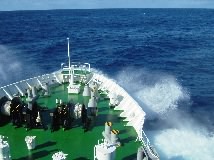For example...
1) US uses the modified Mercalli intensity (MMI) scale.
The MMI consists from twelve steps (I - XII), decided from
dameges of buildings, bodily sensation of shaking and so on.
2) Japan uses the JMA (Japan Meteorological Agency) intensity scale.
The JMA intensity consists from ten steps (0-7),
decided from the seismometers (ground accelarations).
These two different intensity scale cannot be translated precisely,
however, I tried to translate it rougly. The process is detailed as follows.
1) Access to the web site "Earthquake Hazards Program" produced by USGS
(US Geological Survey). >> http://earthquake.usgs.gov/
2) Go to the ShakeMap. >> http://earthquake.usgs.gov/shakemap/
3) Watch a ShakeMap image.
For example, http://earthquake.usgs.gov/eqcenter/shakemap/global/shake/2008ryan/
4) See a color pallet table below the map,
and find the Estimated Intensity values with unit of PEAK ACC(%g).
Each value approximate represents ground accelaration for each MMI.
5) Modify the unit of PEAK ACC.
1%g=0.01*9.8*100cm/s^2=9.8cm/s^2
6) See the JMA web site. You can see the relationship between JMA intensity
and accelaration in the graph (Fig.3).
http://www.seisvol.kishou.go.jp/eq/kyoshin/kaisetsu/comp.htm
cf. written in Japanese.
Here, we assume the frequency of shaking as 0.5 seconds.
We can easily read the accelaration range for each JMA intensity from Fig.3.
Finally, on the basis of the above 5 and 6, we can make a traslation table
between MMI and JMA intensity as follows.
--------------
MMI:JMA
--------------
I : 0-1
II-III: 1-3
IV : 3
V : 4
VI : 5L
VII : 5H
VIII: 6L
IX : 6H-7
X+ : 7
--------------
Although the translation table is not precise,
you can rougly compare the MMI and JMA intensity quickly.
Try it.
* Original Japanese article
>> http://goto33.blog.so-net.ne.jp/2008-06-09-1

No comments:
Post a Comment